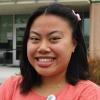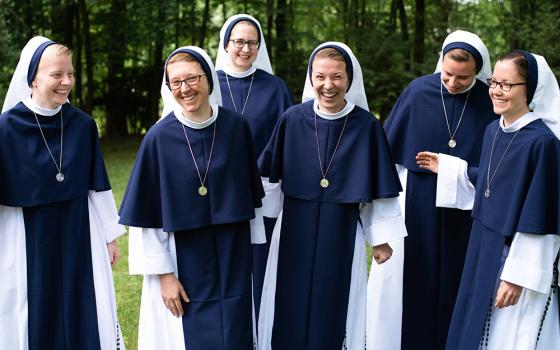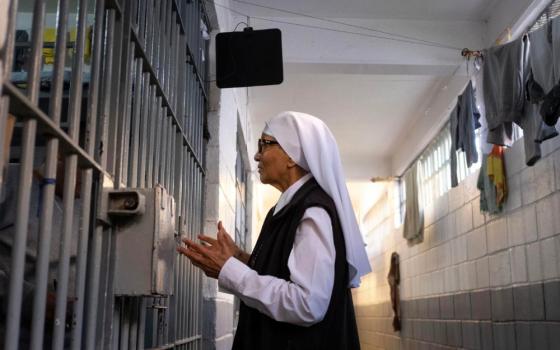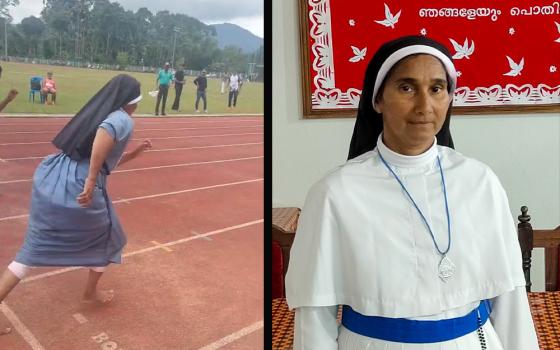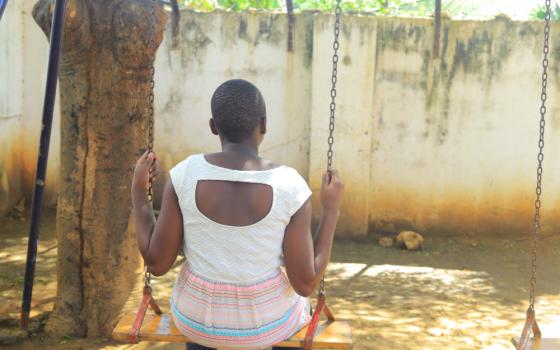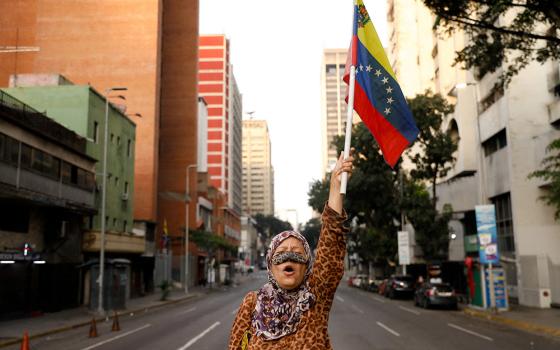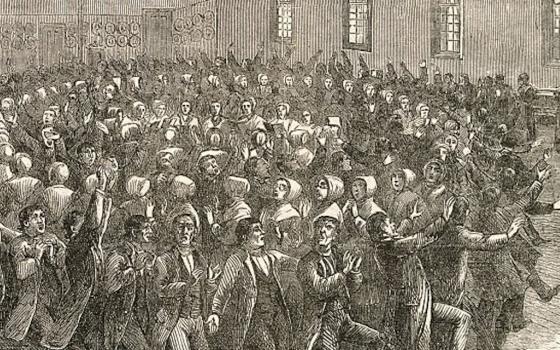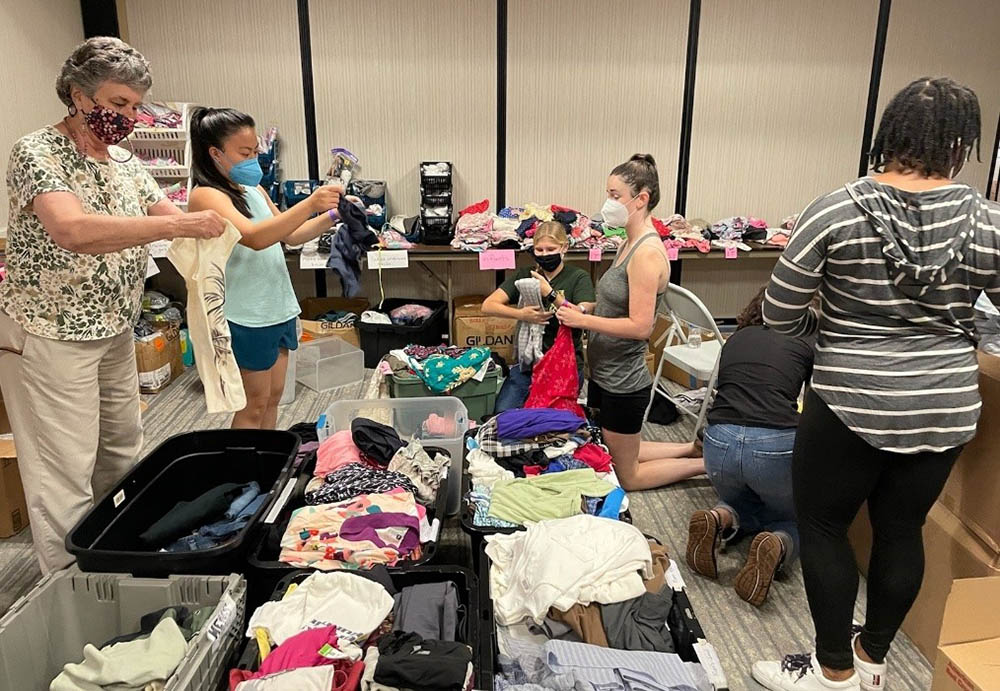
From left: St. Joseph Sr. Louise Ann Micek, Jaesen Evangelista, Emily Michaelis, Emma Shay, Nina Dorsett and Cindy Emenalo. In San Diego, we organized donated clothes for the refugees staying at the migrant hotel who were en route to sponsors across the United States. (Courtesy of Nina Dorsett)
Editor's note: Notes from the Field includes reports from young people volunteering in ministries of Catholic sisters. A partnership with Catholic Volunteer Network, the project began in the summer of 2015. This latest round of the series features volunteers in Orange, California; Nazareth, Kentucky; and New York City. Read more about Jaesen here.
Last August, when I joined the St. Joseph Worker Program of Orange, the first thing we did upon arriving was, not surprisingly, service. We drove down to San Diego to a migrant hotel near the U.S.-Mexico border. There, we supported Catholic Charities, which was helping hundreds of refugees. Though we worked at a different hotel, this article outlines how Catholic Charities ran their operation: "San Diego hotels under contract to temporarily house asylum seekers".
Though some came alone, most were families of three to four people. And these families, recently released by the government, were making their way to their sponsors across the country. Once they arrived at the hotel, each family would stay for 24-48 hours. Then they were transported to the airport for flights to their sponsors.
We only stayed for three days, but we worked nearly 10 hours each day. First, we packaged breakfast meals and delivered them to the refugees' hotel rooms. Then, we oversaw the clothing drive, folding and labeling hundreds of donations, taking orders from families, and delivering bags of clothing to their rooms. And in our very few breaks, we escorted families to the airport.
It was hard work, and though I was extremely anxious, I began to pay attention to the individual families.
Nearly all the refugees had come with only the clothes on their back, so they had not been able to change for days or sometimes weeks. The children, especially, always arrived with shoes that were extremely worn and disheveled.
Fortunately, at the clothing drive there were four crates of children's shoes that ranged from toddler to teenage sizes. When the children saw those crates, they would immediately run to them, take off their old rundown shoes, and replace them with colorful new ones. They were so happy. They ran and danced around in their new shoes and showed them off to every single volunteer.
And I felt so happy for them. I laughed and played with the kids as they danced, and even the parents joined in as they thanked me for bringing some joy to their journey.
Advertisement
It wasn't always happy, though. To be quite frank, there were probably more times of sadness among the immigrants than there were times of joy.
One teenage girl from Brazil came to the hotel alone, and when volunteers tried to talk to her, she cried hysterically. They gave her a pen and paper and asked her to write what she was trying to say. In Portuguese she wrote, "I am looking for my sister. We were separated (during the immigration process) and she promised that she would meet me here, but I do not see her here and I do not know where she is."
Perhaps I am a bit too emotional, but I started to cry, too. I kept thinking of the immense struggle she must have faced to break away from her sister and her longing to be with her again, but having nothing to rely on but the hope that they will reunite someday.
I hugged her. I cried with her. And though we spoke different languages, I stayed with her.
I began to feel love for all the immigrants I met.
I had only short interactions with each one, yet I began to understand their joys and their struggles. I spoke no Portuguese; I spoke no Spanish. Yet I began to recognize their foreign words of affirmation, happiness, and sorrow.
And, with this new love, new compassion, and new empathy, I wanted to stand up for them.
Shortly after the San Diego trip, I began working at my service site at Mission Hospital. My first week was filled with many new experiences: learning about community health, meeting homeless individuals needing health care and, most impactfully, advocating for immigration reform.
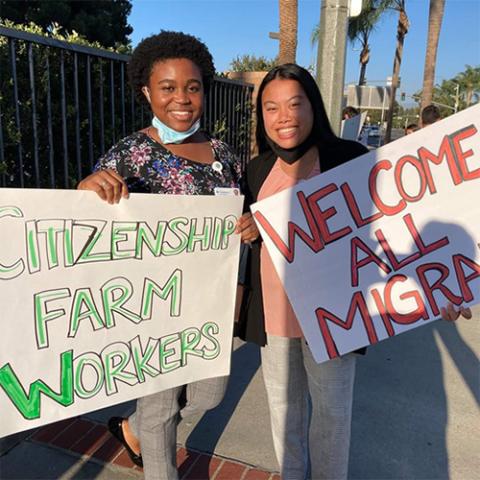
Cindy Emenalo, left, and Jaesen Evangelista. Cindy and I held homemade signs at the "Public Witness" event in Orange, California. (Courtesy of the Sisters of St. Joseph)
In September, Mission Hospital supported the Interfaith Justice Collaborative of South Orange County during its peaceful protest for immigrant rights. It was called "Public Witness" and encouraged people to gather at busy sidewalks and wave signs advocating for migrants. I jumped at the chance. With my recent experience in San Diego, I thought this was a great opportunity to stand for immigrants' rights.
Thirty to forty people were there, including the Sisters of St. Joseph of Orange, elected officials, St. Joseph Workers, and many community members waving homemade signs that read "Citizenship for Farm Workers" and "Welcome All Migrants." Many cars honked as they passed, and many more curious individuals came to join as well.
It was an exciting time and I learned so much about the fight for immigrant rights, such as the global crises forcing innocent people to flee their homes, the excruciatingly long U.S. immigration process, and the inhumane conditions that immigrants face upon arrival.
I also learned about the monarch butterfly symbol. A woman named Sue Connor, who led the event, wore a cape designed as a monarch butterfly's wings. It was beautiful. Occasionally, she would wave her cape in the air and spin around as if she were fluttering about.
I asked her what the monarch butterfly meant, and she said, "The monarch butterfly is the symbol of immigration. The butterflies travel far and wide to escape the harsh winters of North America in order to find a new home that is safe and warm for them. Their migration is the same as those of immigrants coming to the U.S."
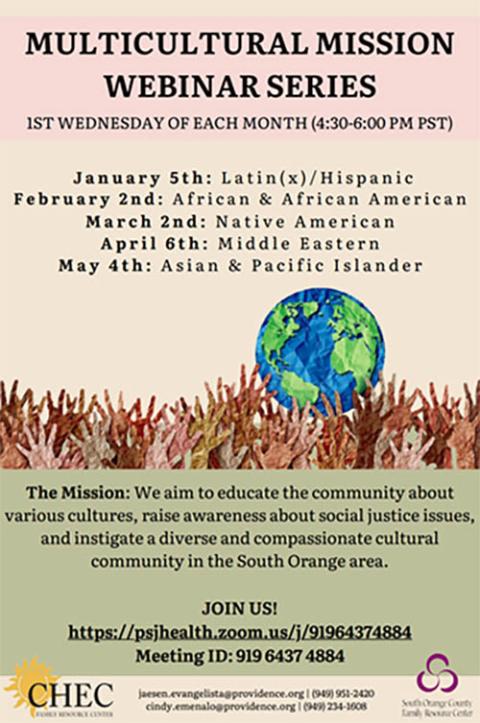
The flyer for our "Multicultural Mission" webinar series (Courtesy of Jaesen Evangelista)
Just like the butterflies, immigrants travel far and wide to escape the harsh environments surrounding their homes. They are forced to flee somewhere foreign in order to feel safe. It's also not their fault for needing to migrate. They are not unjust for wanting to keep their families alive and well. They are not criminals for needing help.
My experience in San Diego and with Public Witness inspired me.
I believe that everyone should see immigrants as beautiful and brave individuals sacrificing everything they have in order to protect themselves. Their journey is long, and we, as their brothers and sisters, should fight for their right to move freely without judgment and without discrimination.
I decided to be part of the movement. Along with my colleague Cindy Emenalo, we quickly and passionately set up a webinar called the "Multicultural Mission" aimed at bringing awareness to various cultures and social justice issues, but most importantly advocating for immigration reform. We gathered individuals from CHIRLA (Coalition for Humane Immigrant Rights of Los Angeles), the Catholic University of America and the Community Action Partnership of Orange County to speak about the social injustices immigrants face upon crossing the border. I learned that the Orange County community is a diverse population of thousands of immigrants. They need their voices heard.
Today, I am still learning about the immigration movement. And, I don't think my service has even scratched the surface of social change. But one thing is certain: I stand as a proud advocate for all refugees. I stand with my brothers and sisters, and I will continue to stand until there is justice for them.
